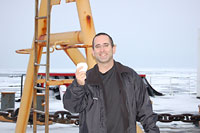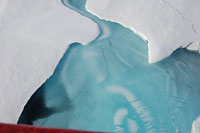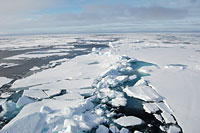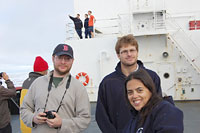

 | |||||||||||||||||
|
|
Journals 2009/2010Jonathan Pazol
August 17, 2009 We headed southwest most of yesterday, crossing one of our earlier lines and making a triangle on the map. Then we turned northwest and have been heading in that direction most of the day. The weather was much colder, and shortly after going on watch, it began to snow - yes, it's August 17th and it's snowing (In contrast, Larry Mayer forwarded us a memo from the University of New Hampshire about heat advisories and that anyone without air conditioning could leave work early - that doesn't quite apply out here). To break the monotony of the long purple map line, several of us went out on the bow mid-watch and made snowballs. I promised my kids a souvenir from the Arctic, so I put it in the freezer, but I don't know if it will last.
Later today the sun came out, the winds died down, and the fog cleared. It was beautiful out. The ocean was calm, and it was quiet enough that you could hear the ice cracks forming ahead of the ship as it pushed its way through. The light was simply breathtaking as it bounced off the ice and water. When people talk about the stark beauty of the Arctic, this is what they mean.
All of a sudden the serenity was broken by an announcement over the "pipes" that a polar bear cub had been spotted about 500 yards off the bow. I have not seen so many people move so fast aboard the ship. Within less than a minute, there were about 40 people crowded on the bow with cameras, video cameras, and binoculars all looking for the cub. Everyone was trying to figure out where the bear was and was looking up toward the bridge to see where the crew was looking. Finally after about 10 minutes, they made an announcement that it was actually not a bear after all. If it was April 1st today, they would have "gotten us good." What I later learned was that our marine mammal observers had seen something out on the ice, thought it was an Arctic fox but couldn't see the tail, so they thought maybe it was a bear cub. Well, that was all the people on the Bridge needed to hear, and they made the announcement. Just after that happened, the observers got a second look and realized it was a fox after all (which then hid before anyone on the bow could see it). Oh well, we all got a little exercise and some fresh air.
Later while up on the bridge, I was able to play biologist again. I spotted a Ringed Seal (Phoca hispida) in one of the open channels in the water. I only saw its head, so I had to get some help from the marine mammal observers for identification. These seals are the smallest ice-associated seals, reaching about 4 feet in length and 120 pounds. They have a gray background with light rings around black spots, and are a food source for polar bears. There have been almost as many seal sightings in 11 days this year as there were in a month-long cruise last year. So, despite the false alarm today, the conditions and thickening ice make the likelihood of a polar bear sighting much higher. |
||||||||||||||||



